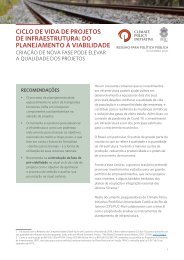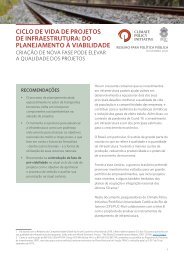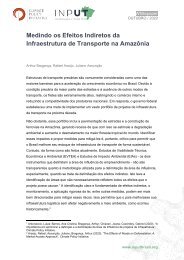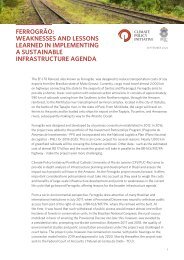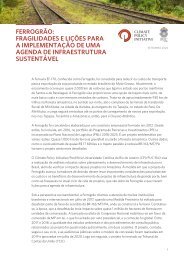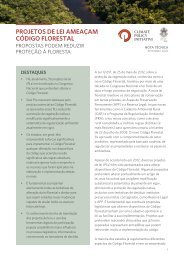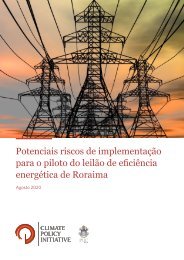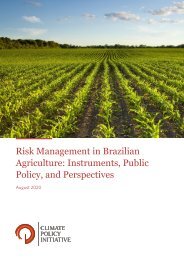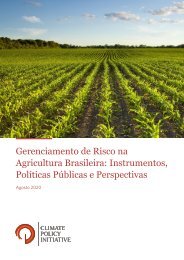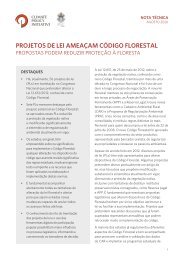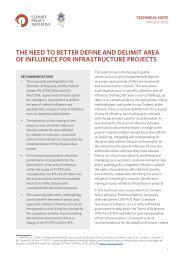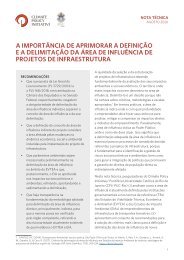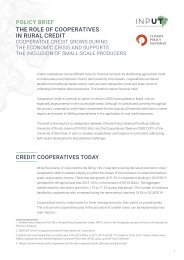Brazil’s Infrastructure Project Life Cycles: from Planning to Viability. Creation of a New Phase May Increase Project Quality
You also want an ePaper? Increase the reach of your titles
YUMPU automatically turns print PDFs into web optimized ePapers that Google loves.
INTRODUCTION TO THE PRE-VIABILITY PHASE<br />
This pre-viability phase should be instituted for large greenfield infrastructure projects <strong>to</strong> be<br />
granted under concession. It contains two stages: (i) the description <strong>of</strong> the project, in which a<br />
questionnaire (see Box 2) must be answered without requiring in-depth studies <strong>to</strong> pinpoint firs<strong>to</strong>rder<br />
obstacles including socio-environmental risks and <strong>to</strong> assess whether these obstacles are<br />
avoidable (or not), and (ii) a socio-environmental complexity analysis (see Box 3) that serves <strong>to</strong><br />
anticipate discussions that are currently only addressing the viability phase by the EVTEA and by<br />
the EIA.<br />
BOX 2. STRUCTURING QUESTIONNAIRE FOR THE PRE-VIABILITY<br />
ANALYSIS STAGE<br />
1. What service does the project seek <strong>to</strong> provide? What is the reason for the project?<br />
2. What problem does the project seek <strong>to</strong> solve? What is the cause or condition that<br />
motivates the existence <strong>of</strong> the project? What is the expected impact?<br />
3. Are the project objectives clear and measurable?<br />
4. Are the project’s objectives clearly related <strong>to</strong> the government’s long-term planning?<br />
5. Is the project synergistic with – or antagonistic <strong>to</strong> – other projects?<br />
6. Are there other projects that provide or seek <strong>to</strong> provide the same type <strong>of</strong> service or<br />
solve the same problem? Do they share the same objectives?<br />
7. Are there other works (completed or halted) that provide or seek <strong>to</strong> provide the same<br />
type <strong>of</strong> service or solve the same problem? Do they share the same objectives?<br />
8. Does the project’s functionality depend on other ventures? For example, ports require<br />
transportation logistics; power generation plants require transmission networks.<br />
9. Which public and/or private entities may react in such a way as <strong>to</strong> impact the<br />
project’s viability?<br />
10. Considering the entities identified above, what possible reactions <strong>to</strong> the project can<br />
be expected (e.g., price reductions, improved service quality, expansions and/or<br />
upgrades <strong>to</strong> existing infrastructure, etc.)?<br />
Once the project has been evaluated using the structuring questionnaire, a socio-environmental<br />
complexity analysis <strong>of</strong> the project should be carried out <strong>to</strong> (re)validate the degree <strong>of</strong> execution<br />
viability. The socio-environmental complexity analysis starts by identifying the geographical<br />
areas directly and indirectly affected by the project and organizes a set <strong>of</strong> questions based on<br />
three axes: terri<strong>to</strong>rial, environmental, and social governance (Box 3). This analysis would draw<br />
upon secondary information <strong>to</strong> answer questions that, without requiring the production <strong>of</strong> new<br />
knowledge, address critical points that help ascertain a given project’s viability.<br />
8



